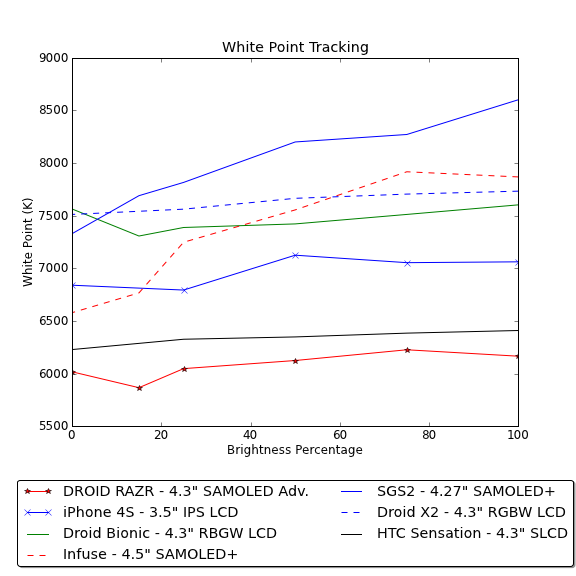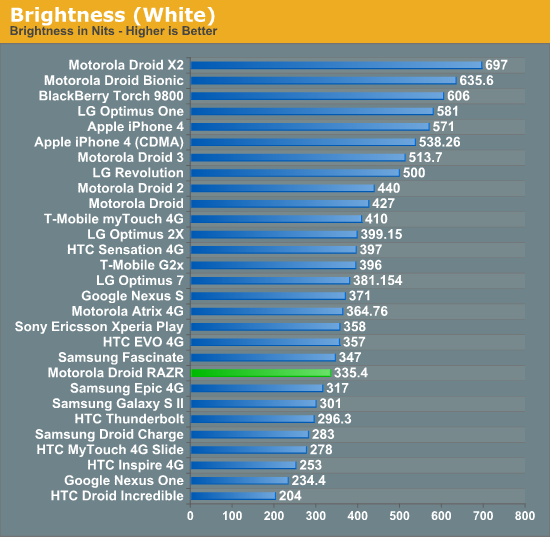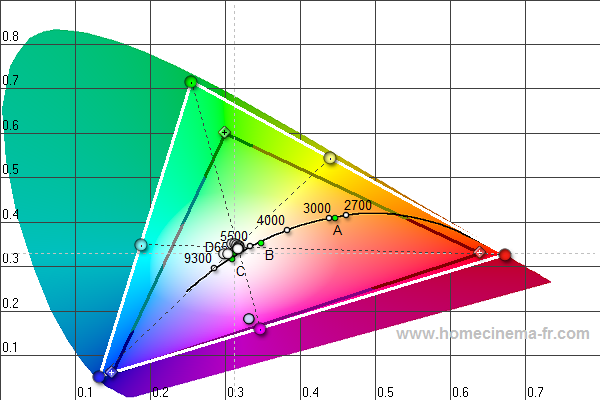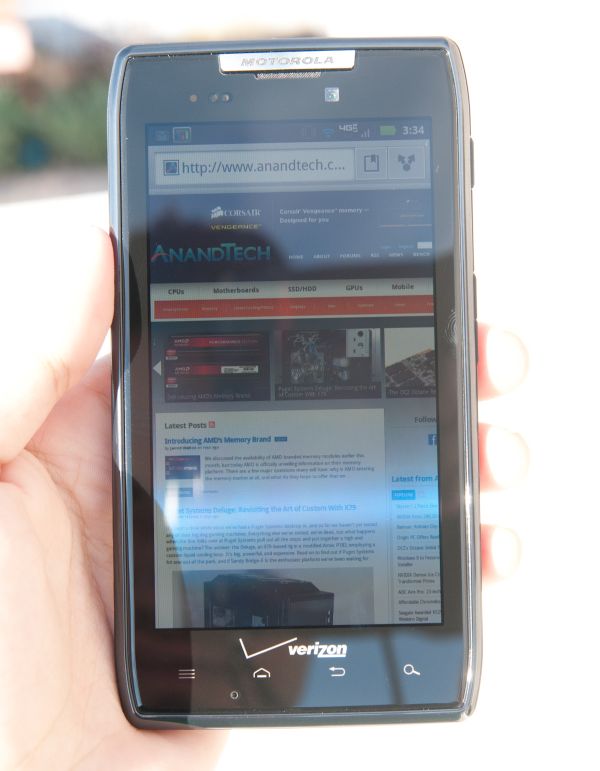Motorola Droid RAZR Review - A Better Clad Bionic
by Brian Klug on December 16, 2011 2:01 AM EST- Posted in
- Smartphones
- Droid
- LTE
- 4G
- Motorola
- Android
- Mobile
- Droid RAZR
- motorola droid RAZR
Super AMOLED Advanced Display
The RAZR is the first Motorola device to ship with an AMOLED panel, and in this case they’ve coined their 4.3” diagonal qHD (960x540) display Super AMOLED Advanced. True to AMOLED naming monikers, this panel includes RGBG PenTile (the absence of “Plus” tells you this one) and Advanced apparently now connotes qHD.
It seems like PenTile is something that mainstream press has finally become aware of, and for whatever reason, the RAZR served as lightning rod for others to voice their discontent with the non-RGB stripe subpixel rendering layout. Maybe it’s because the phone isn’t Samsung-branded (although ironically it is undoubtably manufactured by Samsung), but something about the RAZR display caused more than the usual scrutiny. I think a little bit of a history lesson is in order - since the original Atrix, Motorola has been shipping qHD LCD panels with the RGBW variant of PenTile. The fourth white subpixel helps the LCD system be more efficient - especially when displaying black text on a white background. In that system, luminance gets mapped to the white subpixel, chrominance to RGB.

Some AMOLEDs (Left to Right): SAMOLED (Galaxy S), SAMOLED+ (Galaxy S 2), SAMOLED Advanced (RAZR)
In AMOLED land thus far we’ve only seen RGBG PenTile or RGB subpixel matrixes. By taking advantage of the human visual system’s differing frequency response with respect to wavelength (eg we can detect higher spatial frequencies in the green), the system can emulate a higher resolution system with fewer subpixels. First and second generation AMOLED (“AMOLED” on the Nexus One and others, then Super AMOLED on the Galaxy S / Nexus S) drove an effective resolution of WVGA (800x480) at 3.7” and then 4”, and it was here that subpixels were big enough to pick out with the naked eye, especially on solid colors or single pixel thickness elements.
The thing that gets left out of most discussions about the RAZR’s display is that although RGBG is used, the subpixels have a different geometry than their RGBG first and second generation (AMOLED and Super AMOLED) partners from Samsung. Previously, green subpixels were noticeably thinner than their R and B partners. In this new matrix, they’re much closer to being same size (this also applies to the Galaxy Nexus and any of the new Samsung AMOLED panels that don’t use RGB stripes).
With respect to the RAZR, the combination of this more uniform subpixel geometry and higher effective resolution (qHD) at 4.3” makes RGBG PenTile nowhere near as visually noticeable as it was on phones like Galaxy S. I originally tweeted that I found the RAZR display visually different than other AMOLED panels with RGBG, and this is what I was referring to. Subjectively I’d even say that the RAZR has less characteristic PenTile grain than the RGBW LCD variants I’ve seen recently.
Of course the other side of the story is color rendering and accuracy. One of the most frustrating things with AMOLED that has existed in virtually every iteration is how white point varies sometimes wildly as a function of panel brightness. If you use auto brightness (which I wager almost everyone does to save battery), it can change dramatically and be accentuated by ambient lighting changes that accompany. I set out to measure how much change there is a while ago, and continue measuring brightness, contrast, and white point at different brightness percentages as set in the UI.


Like virtually all AMOLED displays I’ve seen, there’s subjective variance in appearance as a function of brightness. On the RAZR, the measurements with our i1D2 belies how big this is, and at the absolute lowest brightness settings greys can look somewhat green. Again we’ve seen this behavior on numerous AMOLED displays.

I also threw the RAZR at Color HCFR and took measures with Francois’ excellent voodoo screen test patterns application at 100% brightness. The results from a complete run (results in .chc format are here if you want them) are interesting. Starting with the CIE chart, we see the kind of oversaturation that has been long talked about with respect to AMOLED - the inside triangle is the sRGB standard, outside are primary and secondary measures.
Color temperature straddles 6500K and mirrors what measures I took and mentioned elsewhere, of course here we’re looking at it at different IRE values. Likewise, gamma is way above 2.2 and instead average 2.6.
Viewing angles and outdoor response are what we’re used to seeing from SAMOLED. That is to say viewing angles are awesome and outdoor response with an optically bonded panel and top glass isn’t anything to complain about.
I also haven’t seen the RAZR throw a display overheat warning and clamp display brightness either, which is more than I can say for virtually all of the SGS2 variants that I've seen, all of which will throw the overheat error if left in direct sunlight in my climate for too long.


There's two other little things to make note of. First, Motorola made a change to its standard multitouch keyboard and changed the keys to black - this is an interesting and nice little extra feature that might save a bit of battery power. Again, black on AMOLED literally corresponds to the pixels not emitting any light. Last, there's a display power saver checkbox which dims the screen when displaying darker content to save battery - this isn't any surprise, but it's just noteworthy that Samsung isn't alone in including sort of a dynamic contrast function in the guise of saving some battery.

















76 Comments
View All Comments
Devo2007 - Friday, December 16, 2011 - link
Brian Klug - Friday, December 16, 2011 - link
Motorola a few times made specific note that their skin isn't called Blur, even though in build.prop and relevant places, it's called "Blur." I guess it all just boils down to semantics. :)-Brian
yas69 - Friday, December 16, 2011 - link
S2 benchmark values are different with November/December stock firmware.I get 1130 on vellamo with recent S2 firmware. Sunspide/Browsermark values are better than also higher than Razr.
Brian Klug - Saturday, December 17, 2011 - link
What ROM and browser are you tesing in? I can't get any higher than what's in the article on our UK SGS2 with the latest ROM from Kies.-Brian
yas69 - Sunday, December 18, 2011 - link
I9100XWKK2 / I9100XWKL1 both perform better than previous versions.yas69 - Monday, December 19, 2011 - link
sorry.I9100XWKK2 (2.3.6)
Vellamo = 1161
sunspider = 1980
browsermark = 78014
lemmo - Friday, December 16, 2011 - link
Thanks for the review, but do you have any more info on audio quality in terms of music playback? You are saying that it is an improvement over the Bionic but how does it compare to other phones like SGS2 and iPhone?Your detailed review of audio quality on the SGS2 was really helpful and I thought you were going to include this testing methodology on all smartphone reviews from now on...?
kishorshack - Friday, December 16, 2011 - link
Even i expect the same thing brian klug it would be awesome if you update this review someday :)Brian Klug - Saturday, December 17, 2011 - link
We're definitely going to do some more in-depth audio testing, it's something new to me but we've finally got the hardware and methodology, just have to interpret results. I did link to the RMAA runs from here for your own perusal, which we're going to talk a bit more about in the Galaxy Nexus piece.-Brian
lemmo - Saturday, December 17, 2011 - link
Thanks Brian that's great news :)As I asked in my comment below, will you do a comparative audio test with other phones when you do the Nexus review? The test results for just the phone you're testing don't mean much unless we know how they compare. Cheers